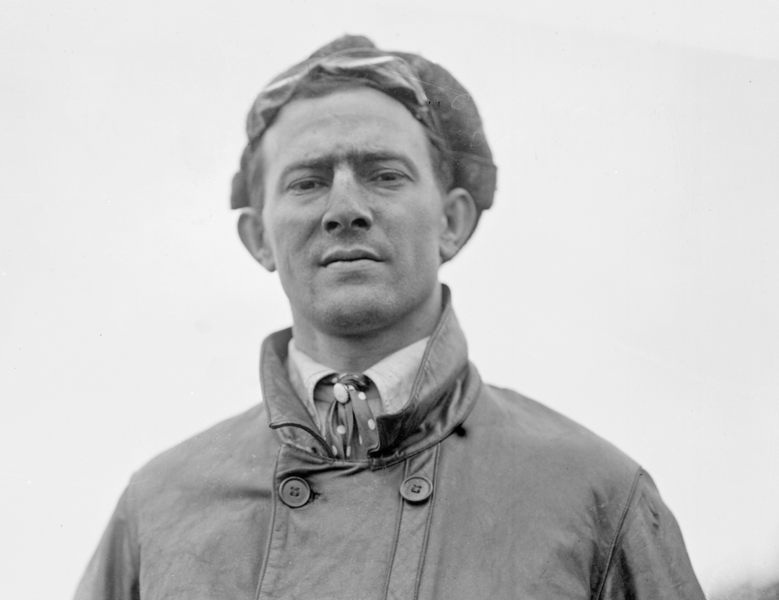
Carl Graham Fisher is best known as the man who created the most iconic racetrack on Earth, the Indianapolis Motor Speedway. Earlier, the Greensburg, IN native helped popularize the automobile by competing against Barney Oldfield and others in a series of lucrative exhibitions on Midwest fair tracks beginning in 1902. He repeatedly urged automakers to support plans for speedways, where they could prove the reliability of their products. When that failed, he persuaded three business associates to join him in the 1909 construction of Indianapolis Motor Speedway, serving as its president until 1923. Fisher may have introduced 500-mile races, rolling starts and pace cars. Among his lesser-known activities were his leadership roles in the Prest-O-Lite company, which produced headlights for almost every early American automobile, the transcontinental Lincoln and Dixie Highways and the establishment of Miami Beach as a resort. Fisher was inducted into the Automotive Hall of Fame in 1971 and the Auto Racing Hall of Fame in 1952. “I just like,” he said, “to see the dirt fly.”
By Donald Davidson
While other purpose-built combination racetrack/testing facilities undoubtedly would have been developed for the benefit of the fledgling automobile industry in the United States more than a century ago, it is reasonable to assume that had it not been for a gentleman named Carl Graham Fisher, the most legendary facility of all — the Indianapolis Motor Speedway — would never have existed.
Fisher, born in rural Greensburg, Indiana, on January 12, 1874, overcame a humble upbringing, limited education and poor eyesight to become a dynamic impresario and visionary. Already the proprietor of a flourishing bicycle sales-and-repair business in downtown Indianapolis at 17, he very likely was the first automobile dealer in the capital city, an encounter at the 1901 New York Auto Show with Ransom E. Olds having resulted in Fisher becoming the Indianapolis "agent" for the Curved Dash Oldsmobile.
In 1904, at a time when driving at night with sufficient illumination was very much an issue, Fisher and a friend were impressed by the experimentations of an inventor named P. C. Avery, who had developed a system fired by compressed carbide gas. The pair reportedly kicked in $2,500 apiece to form what became Prest-O-Lite, a business they sold just 13 years later to Union Carbide for an astonishing $9 million. The friend was James A. Allison, who later founded Allison Engineering. Prest-O-Lite lamps were used on most cars of the period.
By 1905, the tireless Fisher, who briefly raced himself, was strongly advocating the creation of a large racetrack for the purpose of testing automobiles, noting their potential speeds now far exceeded what could reasonably be attained on the nation's still largely dirt roads. The eventual result was, of course, the building in 1909 of Indianapolis Motor Speedway some five-and-a-half miles northwest of the city.
It seems extraordinary that between the fall of 1908 and the summer of 1914, one man could spearhead, as Fisher did, the building of the Indianapolis Motor Speedway; transform the swamplands of Miami Beach, Florida, into an exotic resort area; form the Lincoln Highway Commission, which built the first drivable highway across the United States; father the Dixie Highway; and develop the combination industrial and residential area around IMS, which in 1926 would become the Town of Speedway, Indiana. But Fisher accomplished all of that and more, sometimes promoted with outrageous publicity stunts he performed to fan interest, but always with the emphasis on the project rather than himself.
Sadly, Fisher's fortunes changed dramatically in 1926 when, after he had begun yet another development — Montauk Point on Long Island — a hurricane struck the Miami area. Fisher temporarily halted the Montauk project to rebuild Miami Beach, and while he continued to persevere, by the time he passed away on July 15, 1939, his once-estimated $50 million fortune had taken a major hit.
While he had turned the IMS presidency over to Allison in June, 1923, and had little to do with the track thereafter, Fisher's impact on the lives of millions of people in the interim has been inestimable.
Those numerous fortunates who have enjoyed careers involving the Indianapolis Motor Speedway in any way — winners and Hall of Famers in particular — should drop to their knees and thank Carl Fisher.